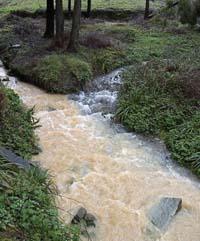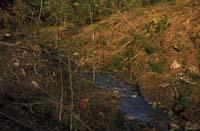Rivers: water and sediments
In the Department of Geodynamics of the UPV/EHU, a study was initiated to analyze the amount of sediments that are suspended from the three main basins of Gipuzkoa, the basins of the Urola, Urumea and Deba. The aim of the research is to analyze the influence of different environmental factors, both natural and human, on the output and transport of these sediments.

Turbidity and sediment concentration
The study of the sediments of these rivers measures the flow, rainfall and turbidity of the water. These measures have been taken continuously for two years.
Turbidity depends on sediments that are transported in suspension with water. This parameter is measured by a probe immersed in water. And to measure sediment concentration there is a sampling in the river.
When it rains, the water rises and the receiver starts to fill the bottles with water. The researchers collect these samples and, once the sampler is emptied, place them again in the river, ready for the next flood. These samples then move to the laboratory, filter and measure the sediments they contain. In this way the sediment concentration is known at that time.
Although interrelated, the relationship between turbidity and sediment concentration is not directly proportional. The type of sediments, size, color... influence turbidity, although the concentration is the same. When establishing the relationship between these two parameters, there is the possibility of knowing the sediment concentration that leaves at all times from the basins, remembering that turbidity is measured uninterruptedly. For each basin this relationship is different.
Human influence
The concentration of sediments that transport the rivers not only depends on rain and flow, but also on the nature of the basin. Since the three basins selected for this study have different characteristics, comparing the results, it is observed that in each case the factors that most influence the output and transport of the sediments are different.

Another human action that affects the concentration of transported sediments is padding on a hillside. The landfill is relatively free and does not have plant protection. Therefore, until this land is compacted and the herbs are covered, more sediments will reach the mouth of the basin.
Full reservoirs
The waters of the three high basins in study feed the reservoirs, so another objective of the study is to know the amount of sediments that the reservoirs receive. In fact, the particles that transport the water to the reservoirs are sedimented at the bottom and, little by little, the reservoirs are filled with sediments. This analyzes the time during which reservoirs can play their role. For example, in the Ebro basin there are reservoirs that have been completely filled with sediments.
The situation of the reservoirs in Euskal Herria is not, at all, so serious. Sediments are released here, but not to fill reservoirs in the short term.
In the future, in addition to the measurements being made in the high basins of the streams, measurements will also be made in the tributaries located above them, in order to improve the fixation of sedimentary sources. It also aims to analyze the chemical characteristics of water.






